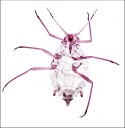Classification
Aphidinae: Macrosiphini
Common name(s)
Coriander aphid
Diagnosis
Apterae are rather small, broadly oval, rather short-legged, mainly dirty greenish with dark-green dorsal mottling and rust-red patches around the bases of short, dark-brown siphunculi; body variably dusted with white mealy wax. Alatae have pale-green abdomen with black dorsal markings, and reddish-brown patches around siphuncular bases. Apterae and alatae 1.3-2.1 mm.
Antennae 0.39-0.4 times as long as body. Processus terminalis twice the length of the base of last antennal segment. Siphunculi shorter than cauda, 0.78 times as long as cauda, and strongly swollen at the base. Cauda bears 6-7 hairs.
Host plant(s)
Apiaceae: Ammi majus Walt., Coriandrum sativum L., Trachyspermum ammi Sprague, Foeniculum vulgare Mill., Cuminum sativum L., Carum copticum Benth. & Hook.
Measurements
Aptera: Length of body 2.36, width 1.50; antennae 0.92, segments III: IV: V: VI 0.23: 0.14: 0.11: (0.09+0.18); u.r.s. 0.11; h.t.2 0.14; siphunculus 0.18; cauda 0.23.
Alata: Length of body 2.01, width 0.9; antennae 1.04, segments III: IV: V: VI 0.32: 0.12: 0.11: (0.09+0.22); u.r.s. 0.12; h.t.2 0.14; siphunculus 0.16; cauda 0.21.
Seasonal occurrence
September-October.
Natural enemies
Coleoptera: Coccinellidae: Brumoides suturalis (F.), Cheilomenes sexmaculata (F.), Coccinella septempunctata L., Propylea japonica (Thunberg).


